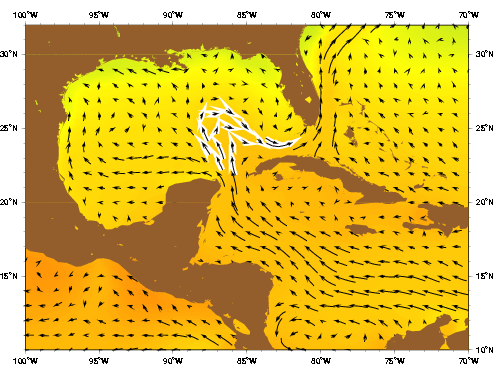
| ||
| The average ship-drift dervied surface velocities show the well-know omega-shaped flow pattern of the Loop current. The Loop Current (1) feeds the Florida Current that transports significant amounts of heat poleward; (2) transports surface waters of tropical origin into the Gulf of Mexico; and (3) is fed by the Caribbean current and the Yucatan Current. Click here for example plots of seasonal averages. | ||
The Loop Current is variable in position. At one extreme, it has an almost direct path to the Florida Current, causing the shear in the flow to set up a quasi-permanent clockwise recirculation known as the Cuban Vortex. This feature may help initiate Loop Current expansion. (Coats, 1992; Nowlin and McLellan, 1967; Cochrane, 1972; Hoffmann and Worley, 1986). At the other extreme, the Loop Current intrudes into the Gulf of Mexico, forming an intense clockwise flow as far north as 29.1N. Occasionally this loop will reach as high as the Mississippi river delta or the Florida continental shelf (Wiseman and Dinnel, 1988; Molinari and Mayer, 1982; Huh et al., 1981; Vukovich et al., 1979). It was this large loop phase of the current from which Nowlin and McClellan (1967) derived the name Loop Current. The Loop Current returns to its direct configuration by slowly pinching off its extension to form a large, warm-core ring that then propagates westward at speeds of 2-5 km day-1 (Coats, 1992; Elliott, 1982; Shay et al., 1998). The 900 km (Auer, 1987) expanse of Loop Current position is reminiscent of the variability in position at the Gulf Stream Extension region.
Early accounts attempted to identify a spring seasonal signal in the Loop current intrusion (Leipper, 1970; Behringer et al, 1977; Nowlin and Hubertz, 1972; Maul, 1977). However, although the intrusion may tend to form more frequently in the spring, it can occur in any season and has periods varying from 6-17 months (Molinari, 1980). Changes in the Yucatan current position have been correlated with Loop Current position, allowing it to serve as index to the extent of the intrusion (Molinari and Cochrane, 1972). However, the manner in which the two currents affect each other with regards to position is as yet unclear. The Loop Current draws its waters from the Yucatan Current, which is ultimately fed by the Caribbean Current, Guiana Current and North Equatorial Current. This provides a vital link between North Atlantic and South Atlantic waters. However, analysis of 12 years of data indicated no significant correlation between monthly Loop Current position and Florida Current transport (Maul and Vukovich, 1993). Although the frequencies of ring separation vary, Sturges (1992) also was unable to correlate ring separation and changes in transport of the Florida Current. The annual fluctuations in Loop Current flow are apparently due to wind forcing (Sturges and Evans, 1983).
The Deepwater Horizon oil spill in the Gulf of Mexico during 2010 has unfortunately shown how important it is to know and understand not just ocean currents, but all aspects of the ocean environment. The long term effects of the oil spill on the Gulf of Mexico's ecosystem are still unknown but scientists will be studying it for many years (links).